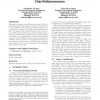Free Online Productivity Tools
i2Speak
i2Symbol
i2OCR
iTex2Img
iWeb2Print
iWeb2Shot
i2Type
iPdf2Split
iPdf2Merge
i2Bopomofo
i2Arabic
i2Style
i2Image
i2PDF
iLatex2Rtf
Sci2ools
ISLPED
2007
ACM
2007
ACM
Analysis of dynamic voltage/frequency scaling in chip-multiprocessors
Fine-grained dynamic voltage/frequency scaling (DVFS) demonstrates great promise for improving the energy-efficiency of chip-multiprocessors (CMPs), which have emerged as a popular way for designers to exploit growing transistor budgets. We examine the tradeoffs involved in the choice of both DVFS control scheme and method by which the processor is partitioned into voltage/frequency islands (VFIs). We simulate real multithreaded commercial and scientific workloads, demonstrating the large real-world potential of DVFS for CMPs. Contrary to the conventional wisdom, we find that the benefits of per-core DVFS are not necessarily large enough to overcome the complexity of having many independent VFIs per chip. Categories and Subject Descriptors C.4 [Performance of Systems]: Design studies General Terms Design, Performance Keywords Dynamic voltage/frequency scaling, chip-multiprocessor
DVFS Control Scheme | Dynamic Voltage/frequency | Fine-grained Dynamic Voltage/frequency | Hardware | ISLPED 2007 |
| Added | 26 Oct 2010 |
| Updated | 26 Oct 2010 |
| Type | Conference |
| Year | 2007 |
| Where | ISLPED |
| Authors | Sebastian Herbert, Diana Marculescu |
Comments (0)

